HA3032 Auditing: Woolworths Business Performance Analysis
VerifiedAdded on 2020/02/18
|18
|4655
|25
Report
AI Summary
This report provides a comprehensive analysis of Woolworths, a leading Australian retailer. It begins with an executive summary highlighting the company's position in the retail sector, its financial practices, and the application of PEST, SWOT, and Porter's Five Forces analyses. The report then delves into Woolworths' business operations, investment and financing activities, and financial reporting practices, which adhere to international accounting standards. Part 2 examines the retail industry's size, growth, supply chain, major players, critical success factors, and key threats. The report further explores legal and environmental regulations, followed by a detailed PEST analysis, SWOT analysis, and Porter's Five Forces analysis in Part 4. Part 5 discusses industry developments, new products and services, business expansion, accounting and regulatory requirements, financial needs, and the use of IT. The report also covers corporate governance, management philosophy, organizational structure, and human resources. The conclusion summarizes the key findings and implications of the analysis. This report is a valuable resource for understanding the complexities of the retail industry and Woolworths' strategic approach within it.

HA3032 Auditing
Trimester 2/2017
1
Trimester 2/2017
1
Paraphrase This Document
Need a fresh take? Get an instant paraphrase of this document with our AI Paraphraser
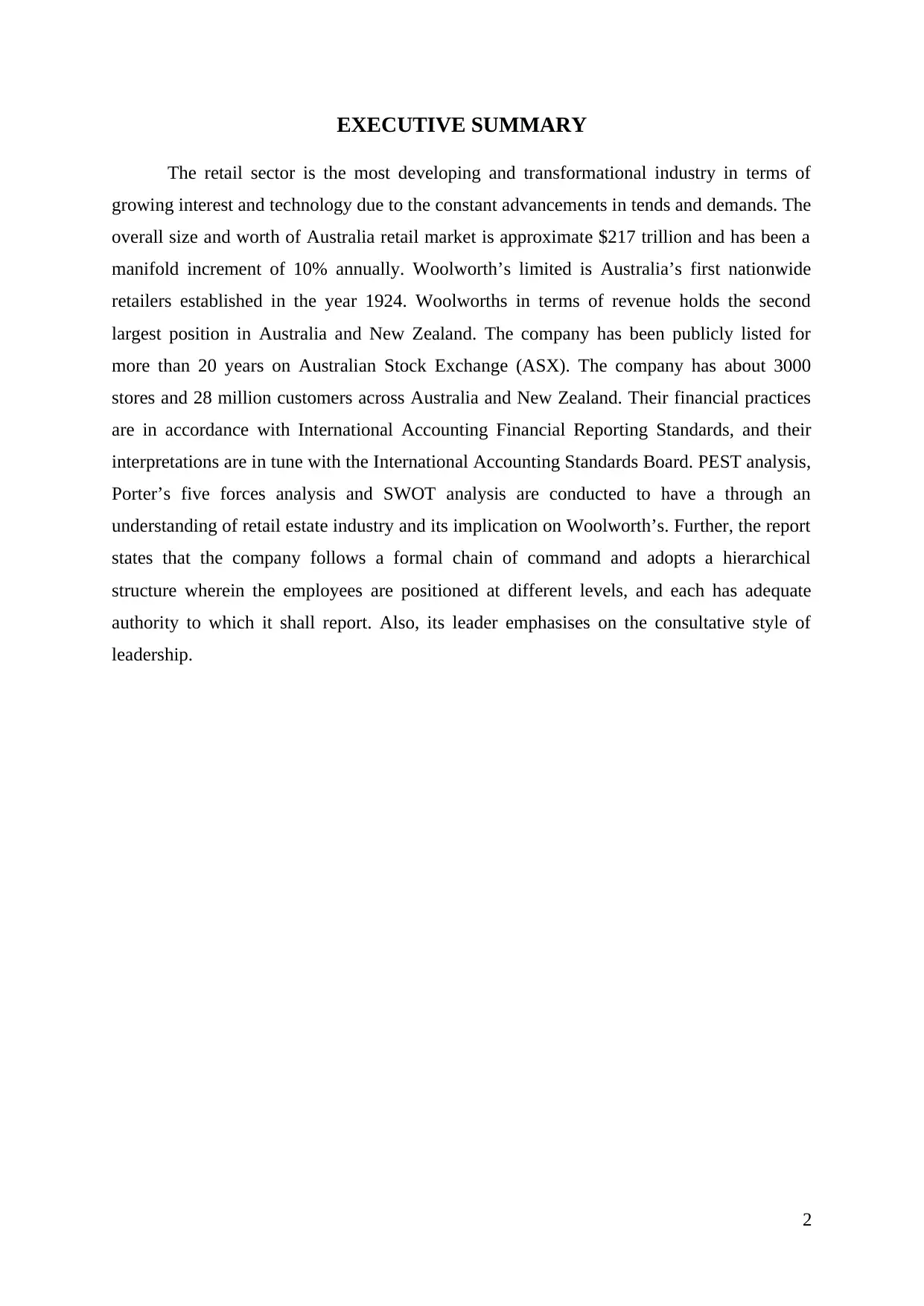
EXECUTIVE SUMMARY
The retail sector is the most developing and transformational industry in terms of
growing interest and technology due to the constant advancements in tends and demands. The
overall size and worth of Australia retail market is approximate $217 trillion and has been a
manifold increment of 10% annually. Woolworth’s limited is Australia’s first nationwide
retailers established in the year 1924. Woolworths in terms of revenue holds the second
largest position in Australia and New Zealand. The company has been publicly listed for
more than 20 years on Australian Stock Exchange (ASX). The company has about 3000
stores and 28 million customers across Australia and New Zealand. Their financial practices
are in accordance with International Accounting Financial Reporting Standards, and their
interpretations are in tune with the International Accounting Standards Board. PEST analysis,
Porter’s five forces analysis and SWOT analysis are conducted to have a through an
understanding of retail estate industry and its implication on Woolworth’s. Further, the report
states that the company follows a formal chain of command and adopts a hierarchical
structure wherein the employees are positioned at different levels, and each has adequate
authority to which it shall report. Also, its leader emphasises on the consultative style of
leadership.
2
The retail sector is the most developing and transformational industry in terms of
growing interest and technology due to the constant advancements in tends and demands. The
overall size and worth of Australia retail market is approximate $217 trillion and has been a
manifold increment of 10% annually. Woolworth’s limited is Australia’s first nationwide
retailers established in the year 1924. Woolworths in terms of revenue holds the second
largest position in Australia and New Zealand. The company has been publicly listed for
more than 20 years on Australian Stock Exchange (ASX). The company has about 3000
stores and 28 million customers across Australia and New Zealand. Their financial practices
are in accordance with International Accounting Financial Reporting Standards, and their
interpretations are in tune with the International Accounting Standards Board. PEST analysis,
Porter’s five forces analysis and SWOT analysis are conducted to have a through an
understanding of retail estate industry and its implication on Woolworth’s. Further, the report
states that the company follows a formal chain of command and adopts a hierarchical
structure wherein the employees are positioned at different levels, and each has adequate
authority to which it shall report. Also, its leader emphasises on the consultative style of
leadership.
2
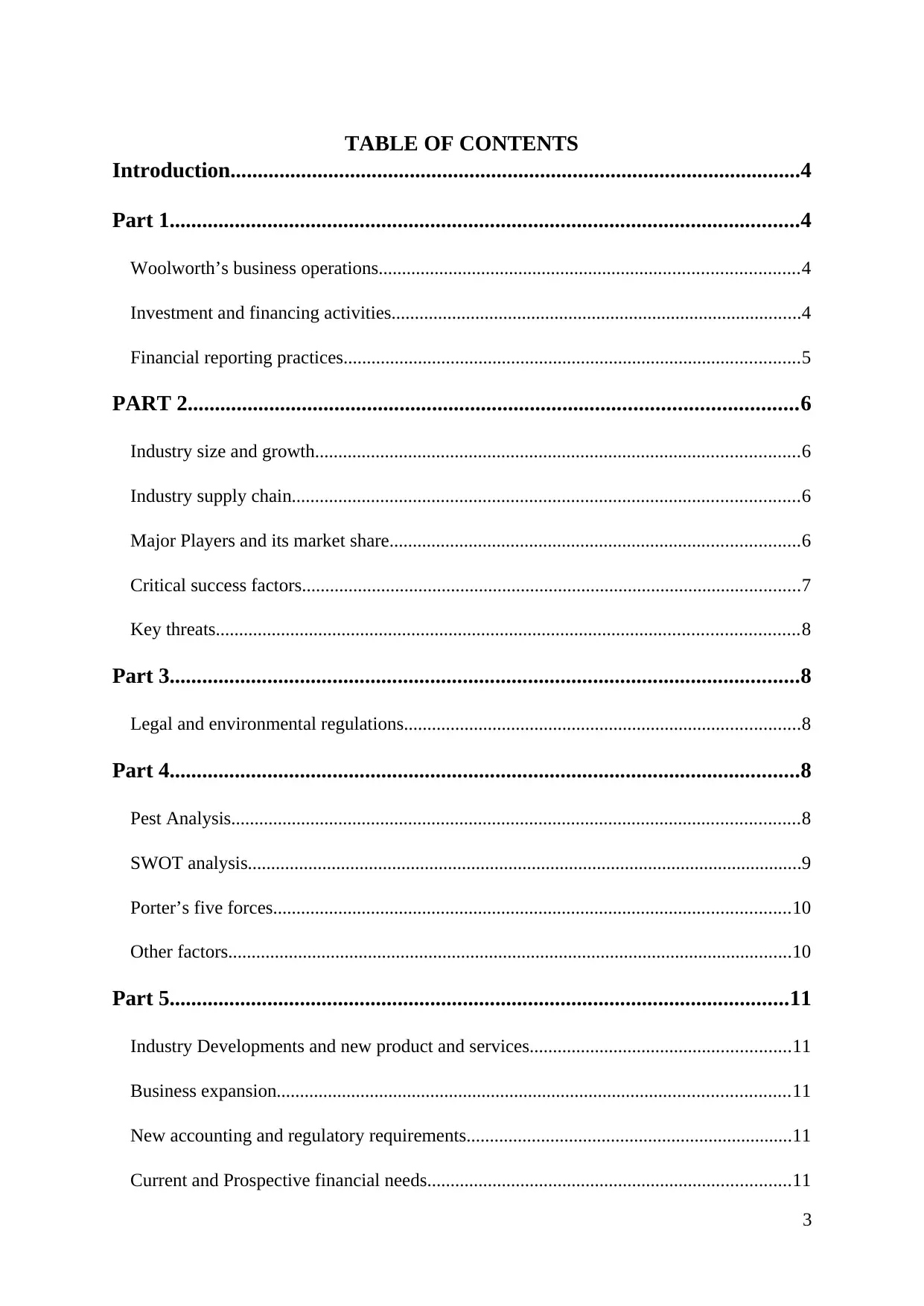
TABLE OF CONTENTS
Introduction.........................................................................................................4
Part 1....................................................................................................................4
Woolworth’s business operations..........................................................................................4
Investment and financing activities........................................................................................4
Financial reporting practices..................................................................................................5
PART 2................................................................................................................6
Industry size and growth........................................................................................................6
Industry supply chain.............................................................................................................6
Major Players and its market share........................................................................................6
Critical success factors...........................................................................................................7
Key threats.............................................................................................................................8
Part 3....................................................................................................................8
Legal and environmental regulations.....................................................................................8
Part 4....................................................................................................................8
Pest Analysis..........................................................................................................................8
SWOT analysis.......................................................................................................................9
Porter’s five forces...............................................................................................................10
Other factors.........................................................................................................................10
Part 5..................................................................................................................11
Industry Developments and new product and services........................................................11
Business expansion..............................................................................................................11
New accounting and regulatory requirements......................................................................11
Current and Prospective financial needs..............................................................................11
3
Introduction.........................................................................................................4
Part 1....................................................................................................................4
Woolworth’s business operations..........................................................................................4
Investment and financing activities........................................................................................4
Financial reporting practices..................................................................................................5
PART 2................................................................................................................6
Industry size and growth........................................................................................................6
Industry supply chain.............................................................................................................6
Major Players and its market share........................................................................................6
Critical success factors...........................................................................................................7
Key threats.............................................................................................................................8
Part 3....................................................................................................................8
Legal and environmental regulations.....................................................................................8
Part 4....................................................................................................................8
Pest Analysis..........................................................................................................................8
SWOT analysis.......................................................................................................................9
Porter’s five forces...............................................................................................................10
Other factors.........................................................................................................................10
Part 5..................................................................................................................11
Industry Developments and new product and services........................................................11
Business expansion..............................................................................................................11
New accounting and regulatory requirements......................................................................11
Current and Prospective financial needs..............................................................................11
3
⊘ This is a preview!⊘
Do you want full access?
Subscribe today to unlock all pages.

Trusted by 1+ million students worldwide
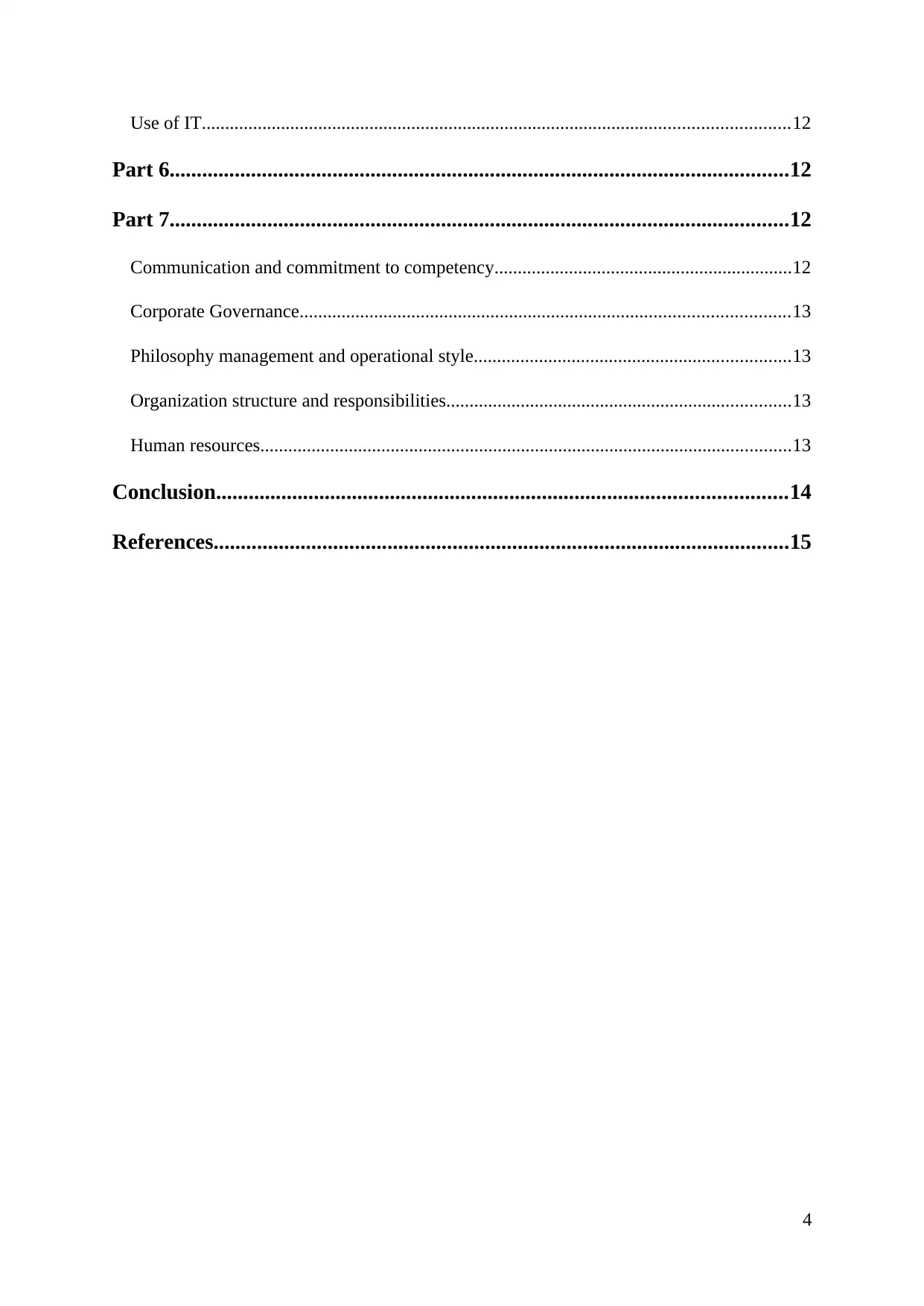
Use of IT..............................................................................................................................12
Part 6..................................................................................................................12
Part 7..................................................................................................................12
Communication and commitment to competency................................................................12
Corporate Governance.........................................................................................................13
Philosophy management and operational style....................................................................13
Organization structure and responsibilities..........................................................................13
Human resources..................................................................................................................13
Conclusion.........................................................................................................14
References..........................................................................................................15
4
Part 6..................................................................................................................12
Part 7..................................................................................................................12
Communication and commitment to competency................................................................12
Corporate Governance.........................................................................................................13
Philosophy management and operational style....................................................................13
Organization structure and responsibilities..........................................................................13
Human resources..................................................................................................................13
Conclusion.........................................................................................................14
References..........................................................................................................15
4
Paraphrase This Document
Need a fresh take? Get an instant paraphrase of this document with our AI Paraphraser
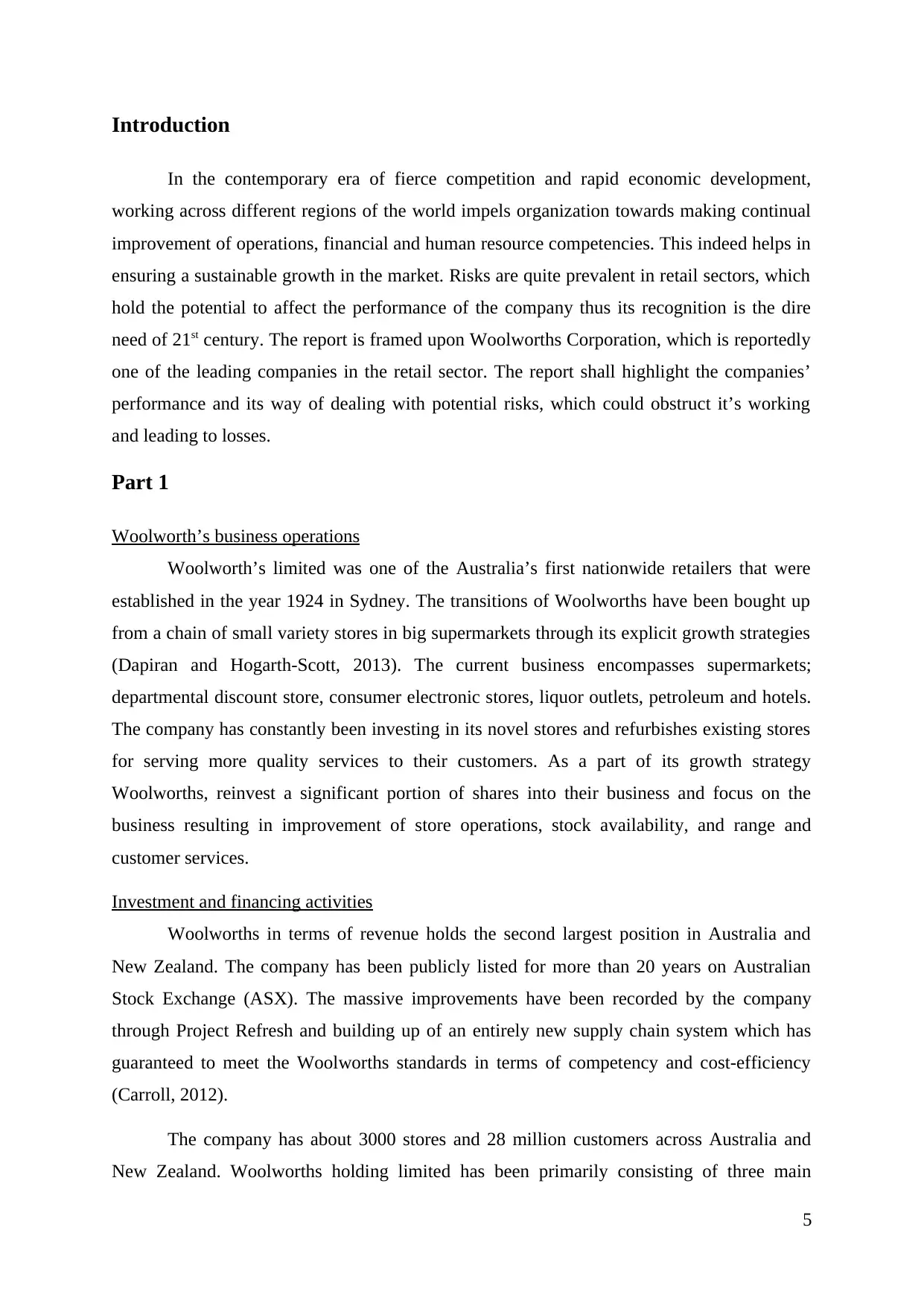
Introduction
In the contemporary era of fierce competition and rapid economic development,
working across different regions of the world impels organization towards making continual
improvement of operations, financial and human resource competencies. This indeed helps in
ensuring a sustainable growth in the market. Risks are quite prevalent in retail sectors, which
hold the potential to affect the performance of the company thus its recognition is the dire
need of 21st century. The report is framed upon Woolworths Corporation, which is reportedly
one of the leading companies in the retail sector. The report shall highlight the companies’
performance and its way of dealing with potential risks, which could obstruct it’s working
and leading to losses.
Part 1
Woolworth’s business operations
Woolworth’s limited was one of the Australia’s first nationwide retailers that were
established in the year 1924 in Sydney. The transitions of Woolworths have been bought up
from a chain of small variety stores in big supermarkets through its explicit growth strategies
(Dapiran and Hogarth-Scott, 2013). The current business encompasses supermarkets;
departmental discount store, consumer electronic stores, liquor outlets, petroleum and hotels.
The company has constantly been investing in its novel stores and refurbishes existing stores
for serving more quality services to their customers. As a part of its growth strategy
Woolworths, reinvest a significant portion of shares into their business and focus on the
business resulting in improvement of store operations, stock availability, and range and
customer services.
Investment and financing activities
Woolworths in terms of revenue holds the second largest position in Australia and
New Zealand. The company has been publicly listed for more than 20 years on Australian
Stock Exchange (ASX). The massive improvements have been recorded by the company
through Project Refresh and building up of an entirely new supply chain system which has
guaranteed to meet the Woolworths standards in terms of competency and cost-efficiency
(Carroll, 2012).
The company has about 3000 stores and 28 million customers across Australia and
New Zealand. Woolworths holding limited has been primarily consisting of three main
5
In the contemporary era of fierce competition and rapid economic development,
working across different regions of the world impels organization towards making continual
improvement of operations, financial and human resource competencies. This indeed helps in
ensuring a sustainable growth in the market. Risks are quite prevalent in retail sectors, which
hold the potential to affect the performance of the company thus its recognition is the dire
need of 21st century. The report is framed upon Woolworths Corporation, which is reportedly
one of the leading companies in the retail sector. The report shall highlight the companies’
performance and its way of dealing with potential risks, which could obstruct it’s working
and leading to losses.
Part 1
Woolworth’s business operations
Woolworth’s limited was one of the Australia’s first nationwide retailers that were
established in the year 1924 in Sydney. The transitions of Woolworths have been bought up
from a chain of small variety stores in big supermarkets through its explicit growth strategies
(Dapiran and Hogarth-Scott, 2013). The current business encompasses supermarkets;
departmental discount store, consumer electronic stores, liquor outlets, petroleum and hotels.
The company has constantly been investing in its novel stores and refurbishes existing stores
for serving more quality services to their customers. As a part of its growth strategy
Woolworths, reinvest a significant portion of shares into their business and focus on the
business resulting in improvement of store operations, stock availability, and range and
customer services.
Investment and financing activities
Woolworths in terms of revenue holds the second largest position in Australia and
New Zealand. The company has been publicly listed for more than 20 years on Australian
Stock Exchange (ASX). The massive improvements have been recorded by the company
through Project Refresh and building up of an entirely new supply chain system which has
guaranteed to meet the Woolworths standards in terms of competency and cost-efficiency
(Carroll, 2012).
The company has about 3000 stores and 28 million customers across Australia and
New Zealand. Woolworths holding limited has been primarily consisting of three main
5
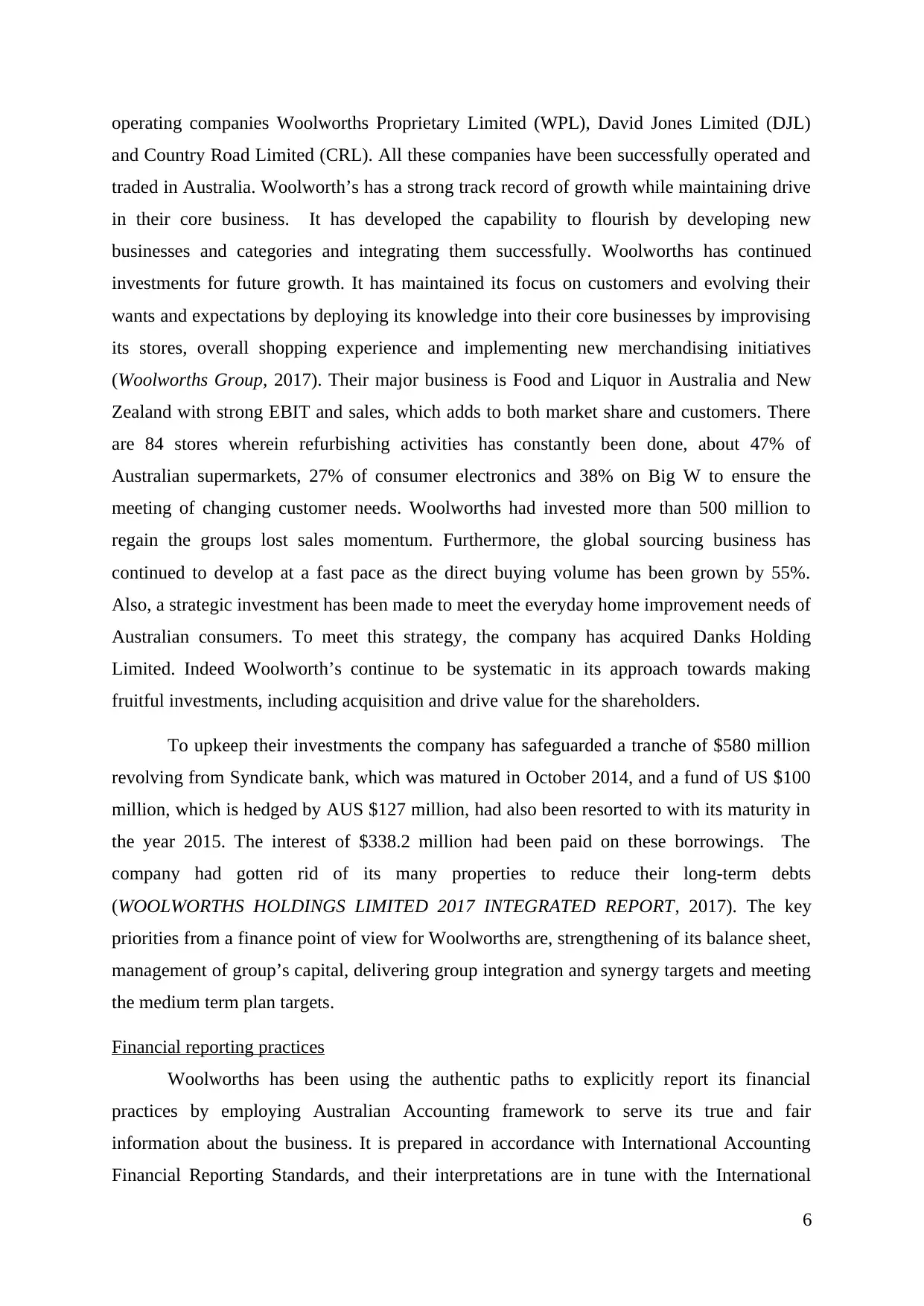
operating companies Woolworths Proprietary Limited (WPL), David Jones Limited (DJL)
and Country Road Limited (CRL). All these companies have been successfully operated and
traded in Australia. Woolworth’s has a strong track record of growth while maintaining drive
in their core business. It has developed the capability to flourish by developing new
businesses and categories and integrating them successfully. Woolworths has continued
investments for future growth. It has maintained its focus on customers and evolving their
wants and expectations by deploying its knowledge into their core businesses by improvising
its stores, overall shopping experience and implementing new merchandising initiatives
(Woolworths Group, 2017). Their major business is Food and Liquor in Australia and New
Zealand with strong EBIT and sales, which adds to both market share and customers. There
are 84 stores wherein refurbishing activities has constantly been done, about 47% of
Australian supermarkets, 27% of consumer electronics and 38% on Big W to ensure the
meeting of changing customer needs. Woolworths had invested more than 500 million to
regain the groups lost sales momentum. Furthermore, the global sourcing business has
continued to develop at a fast pace as the direct buying volume has been grown by 55%.
Also, a strategic investment has been made to meet the everyday home improvement needs of
Australian consumers. To meet this strategy, the company has acquired Danks Holding
Limited. Indeed Woolworth’s continue to be systematic in its approach towards making
fruitful investments, including acquisition and drive value for the shareholders.
To upkeep their investments the company has safeguarded a tranche of $580 million
revolving from Syndicate bank, which was matured in October 2014, and a fund of US $100
million, which is hedged by AUS $127 million, had also been resorted to with its maturity in
the year 2015. The interest of $338.2 million had been paid on these borrowings. The
company had gotten rid of its many properties to reduce their long-term debts
(WOOLWORTHS HOLDINGS LIMITED 2017 INTEGRATED REPORT, 2017). The key
priorities from a finance point of view for Woolworths are, strengthening of its balance sheet,
management of group’s capital, delivering group integration and synergy targets and meeting
the medium term plan targets.
Financial reporting practices
Woolworths has been using the authentic paths to explicitly report its financial
practices by employing Australian Accounting framework to serve its true and fair
information about the business. It is prepared in accordance with International Accounting
Financial Reporting Standards, and their interpretations are in tune with the International
6
and Country Road Limited (CRL). All these companies have been successfully operated and
traded in Australia. Woolworth’s has a strong track record of growth while maintaining drive
in their core business. It has developed the capability to flourish by developing new
businesses and categories and integrating them successfully. Woolworths has continued
investments for future growth. It has maintained its focus on customers and evolving their
wants and expectations by deploying its knowledge into their core businesses by improvising
its stores, overall shopping experience and implementing new merchandising initiatives
(Woolworths Group, 2017). Their major business is Food and Liquor in Australia and New
Zealand with strong EBIT and sales, which adds to both market share and customers. There
are 84 stores wherein refurbishing activities has constantly been done, about 47% of
Australian supermarkets, 27% of consumer electronics and 38% on Big W to ensure the
meeting of changing customer needs. Woolworths had invested more than 500 million to
regain the groups lost sales momentum. Furthermore, the global sourcing business has
continued to develop at a fast pace as the direct buying volume has been grown by 55%.
Also, a strategic investment has been made to meet the everyday home improvement needs of
Australian consumers. To meet this strategy, the company has acquired Danks Holding
Limited. Indeed Woolworth’s continue to be systematic in its approach towards making
fruitful investments, including acquisition and drive value for the shareholders.
To upkeep their investments the company has safeguarded a tranche of $580 million
revolving from Syndicate bank, which was matured in October 2014, and a fund of US $100
million, which is hedged by AUS $127 million, had also been resorted to with its maturity in
the year 2015. The interest of $338.2 million had been paid on these borrowings. The
company had gotten rid of its many properties to reduce their long-term debts
(WOOLWORTHS HOLDINGS LIMITED 2017 INTEGRATED REPORT, 2017). The key
priorities from a finance point of view for Woolworths are, strengthening of its balance sheet,
management of group’s capital, delivering group integration and synergy targets and meeting
the medium term plan targets.
Financial reporting practices
Woolworths has been using the authentic paths to explicitly report its financial
practices by employing Australian Accounting framework to serve its true and fair
information about the business. It is prepared in accordance with International Accounting
Financial Reporting Standards, and their interpretations are in tune with the International
6
⊘ This is a preview!⊘
Do you want full access?
Subscribe today to unlock all pages.

Trusted by 1+ million students worldwide
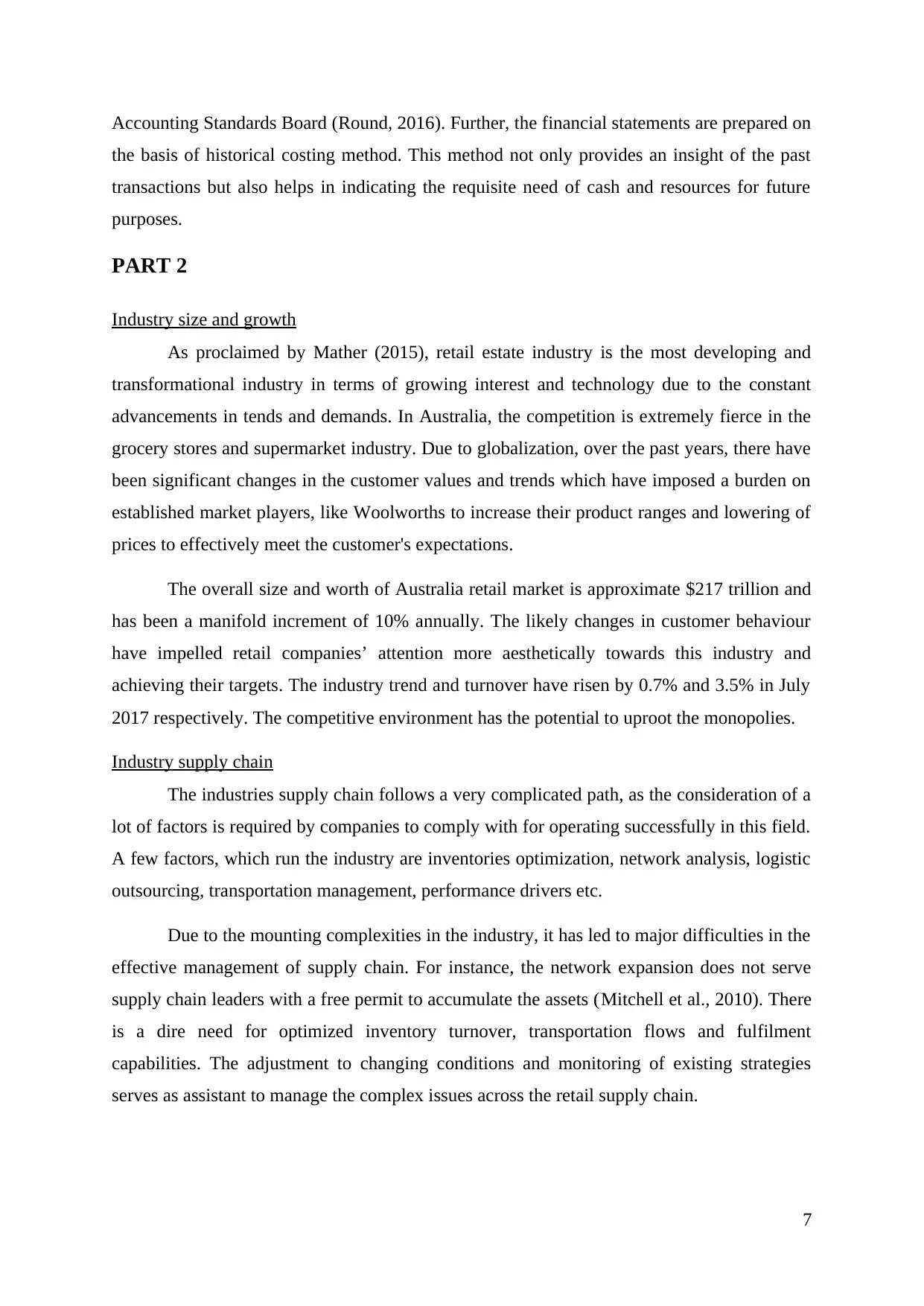
Accounting Standards Board (Round, 2016). Further, the financial statements are prepared on
the basis of historical costing method. This method not only provides an insight of the past
transactions but also helps in indicating the requisite need of cash and resources for future
purposes.
PART 2
Industry size and growth
As proclaimed by Mather (2015), retail estate industry is the most developing and
transformational industry in terms of growing interest and technology due to the constant
advancements in tends and demands. In Australia, the competition is extremely fierce in the
grocery stores and supermarket industry. Due to globalization, over the past years, there have
been significant changes in the customer values and trends which have imposed a burden on
established market players, like Woolworths to increase their product ranges and lowering of
prices to effectively meet the customer's expectations.
The overall size and worth of Australia retail market is approximate $217 trillion and
has been a manifold increment of 10% annually. The likely changes in customer behaviour
have impelled retail companies’ attention more aesthetically towards this industry and
achieving their targets. The industry trend and turnover have risen by 0.7% and 3.5% in July
2017 respectively. The competitive environment has the potential to uproot the monopolies.
Industry supply chain
The industries supply chain follows a very complicated path, as the consideration of a
lot of factors is required by companies to comply with for operating successfully in this field.
A few factors, which run the industry are inventories optimization, network analysis, logistic
outsourcing, transportation management, performance drivers etc.
Due to the mounting complexities in the industry, it has led to major difficulties in the
effective management of supply chain. For instance, the network expansion does not serve
supply chain leaders with a free permit to accumulate the assets (Mitchell et al., 2010). There
is a dire need for optimized inventory turnover, transportation flows and fulfilment
capabilities. The adjustment to changing conditions and monitoring of existing strategies
serves as assistant to manage the complex issues across the retail supply chain.
7
the basis of historical costing method. This method not only provides an insight of the past
transactions but also helps in indicating the requisite need of cash and resources for future
purposes.
PART 2
Industry size and growth
As proclaimed by Mather (2015), retail estate industry is the most developing and
transformational industry in terms of growing interest and technology due to the constant
advancements in tends and demands. In Australia, the competition is extremely fierce in the
grocery stores and supermarket industry. Due to globalization, over the past years, there have
been significant changes in the customer values and trends which have imposed a burden on
established market players, like Woolworths to increase their product ranges and lowering of
prices to effectively meet the customer's expectations.
The overall size and worth of Australia retail market is approximate $217 trillion and
has been a manifold increment of 10% annually. The likely changes in customer behaviour
have impelled retail companies’ attention more aesthetically towards this industry and
achieving their targets. The industry trend and turnover have risen by 0.7% and 3.5% in July
2017 respectively. The competitive environment has the potential to uproot the monopolies.
Industry supply chain
The industries supply chain follows a very complicated path, as the consideration of a
lot of factors is required by companies to comply with for operating successfully in this field.
A few factors, which run the industry are inventories optimization, network analysis, logistic
outsourcing, transportation management, performance drivers etc.
Due to the mounting complexities in the industry, it has led to major difficulties in the
effective management of supply chain. For instance, the network expansion does not serve
supply chain leaders with a free permit to accumulate the assets (Mitchell et al., 2010). There
is a dire need for optimized inventory turnover, transportation flows and fulfilment
capabilities. The adjustment to changing conditions and monitoring of existing strategies
serves as assistant to manage the complex issues across the retail supply chain.
7
Paraphrase This Document
Need a fresh take? Get an instant paraphrase of this document with our AI Paraphraser
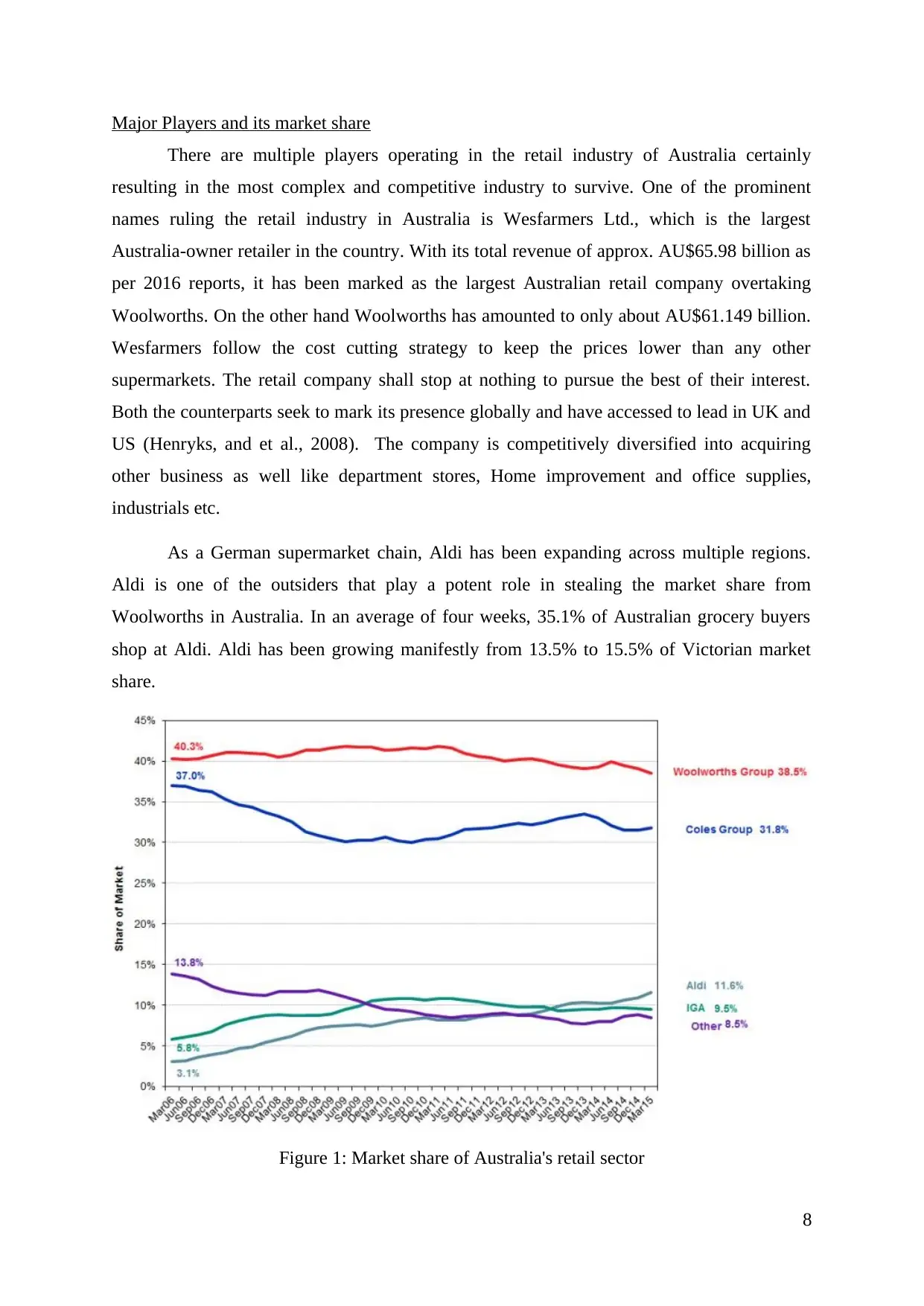
Major Players and its market share
There are multiple players operating in the retail industry of Australia certainly
resulting in the most complex and competitive industry to survive. One of the prominent
names ruling the retail industry in Australia is Wesfarmers Ltd., which is the largest
Australia-owner retailer in the country. With its total revenue of approx. AU$65.98 billion as
per 2016 reports, it has been marked as the largest Australian retail company overtaking
Woolworths. On the other hand Woolworths has amounted to only about AU$61.149 billion.
Wesfarmers follow the cost cutting strategy to keep the prices lower than any other
supermarkets. The retail company shall stop at nothing to pursue the best of their interest.
Both the counterparts seek to mark its presence globally and have accessed to lead in UK and
US (Henryks, and et al., 2008). The company is competitively diversified into acquiring
other business as well like department stores, Home improvement and office supplies,
industrials etc.
As a German supermarket chain, Aldi has been expanding across multiple regions.
Aldi is one of the outsiders that play a potent role in stealing the market share from
Woolworths in Australia. In an average of four weeks, 35.1% of Australian grocery buyers
shop at Aldi. Aldi has been growing manifestly from 13.5% to 15.5% of Victorian market
share.
Figure 1: Market share of Australia's retail sector
8
There are multiple players operating in the retail industry of Australia certainly
resulting in the most complex and competitive industry to survive. One of the prominent
names ruling the retail industry in Australia is Wesfarmers Ltd., which is the largest
Australia-owner retailer in the country. With its total revenue of approx. AU$65.98 billion as
per 2016 reports, it has been marked as the largest Australian retail company overtaking
Woolworths. On the other hand Woolworths has amounted to only about AU$61.149 billion.
Wesfarmers follow the cost cutting strategy to keep the prices lower than any other
supermarkets. The retail company shall stop at nothing to pursue the best of their interest.
Both the counterparts seek to mark its presence globally and have accessed to lead in UK and
US (Henryks, and et al., 2008). The company is competitively diversified into acquiring
other business as well like department stores, Home improvement and office supplies,
industrials etc.
As a German supermarket chain, Aldi has been expanding across multiple regions.
Aldi is one of the outsiders that play a potent role in stealing the market share from
Woolworths in Australia. In an average of four weeks, 35.1% of Australian grocery buyers
shop at Aldi. Aldi has been growing manifestly from 13.5% to 15.5% of Victorian market
share.
Figure 1: Market share of Australia's retail sector
8
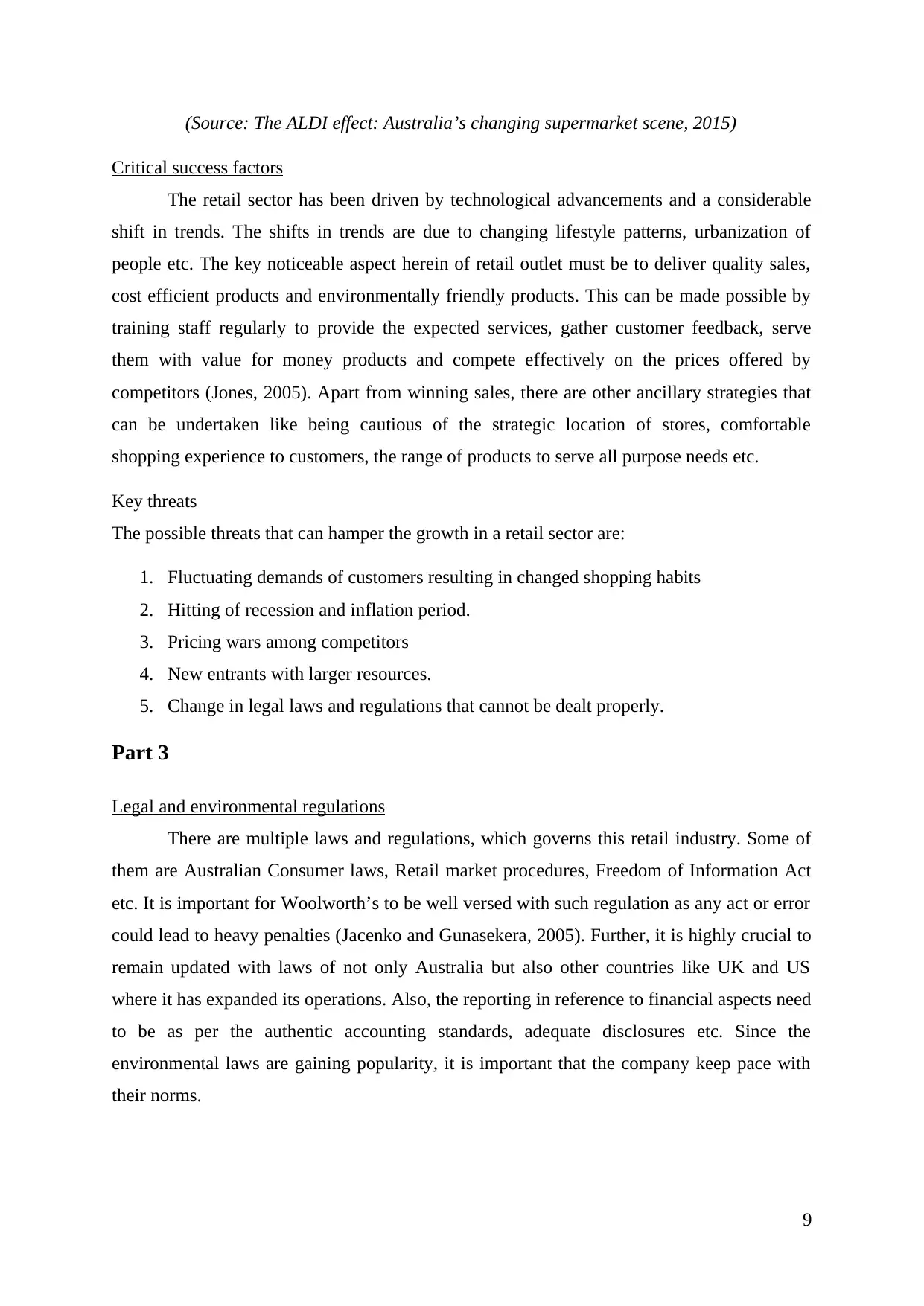
(Source: The ALDI effect: Australia’s changing supermarket scene, 2015)
Critical success factors
The retail sector has been driven by technological advancements and a considerable
shift in trends. The shifts in trends are due to changing lifestyle patterns, urbanization of
people etc. The key noticeable aspect herein of retail outlet must be to deliver quality sales,
cost efficient products and environmentally friendly products. This can be made possible by
training staff regularly to provide the expected services, gather customer feedback, serve
them with value for money products and compete effectively on the prices offered by
competitors (Jones, 2005). Apart from winning sales, there are other ancillary strategies that
can be undertaken like being cautious of the strategic location of stores, comfortable
shopping experience to customers, the range of products to serve all purpose needs etc.
Key threats
The possible threats that can hamper the growth in a retail sector are:
1. Fluctuating demands of customers resulting in changed shopping habits
2. Hitting of recession and inflation period.
3. Pricing wars among competitors
4. New entrants with larger resources.
5. Change in legal laws and regulations that cannot be dealt properly.
Part 3
Legal and environmental regulations
There are multiple laws and regulations, which governs this retail industry. Some of
them are Australian Consumer laws, Retail market procedures, Freedom of Information Act
etc. It is important for Woolworth’s to be well versed with such regulation as any act or error
could lead to heavy penalties (Jacenko and Gunasekera, 2005). Further, it is highly crucial to
remain updated with laws of not only Australia but also other countries like UK and US
where it has expanded its operations. Also, the reporting in reference to financial aspects need
to be as per the authentic accounting standards, adequate disclosures etc. Since the
environmental laws are gaining popularity, it is important that the company keep pace with
their norms.
9
Critical success factors
The retail sector has been driven by technological advancements and a considerable
shift in trends. The shifts in trends are due to changing lifestyle patterns, urbanization of
people etc. The key noticeable aspect herein of retail outlet must be to deliver quality sales,
cost efficient products and environmentally friendly products. This can be made possible by
training staff regularly to provide the expected services, gather customer feedback, serve
them with value for money products and compete effectively on the prices offered by
competitors (Jones, 2005). Apart from winning sales, there are other ancillary strategies that
can be undertaken like being cautious of the strategic location of stores, comfortable
shopping experience to customers, the range of products to serve all purpose needs etc.
Key threats
The possible threats that can hamper the growth in a retail sector are:
1. Fluctuating demands of customers resulting in changed shopping habits
2. Hitting of recession and inflation period.
3. Pricing wars among competitors
4. New entrants with larger resources.
5. Change in legal laws and regulations that cannot be dealt properly.
Part 3
Legal and environmental regulations
There are multiple laws and regulations, which governs this retail industry. Some of
them are Australian Consumer laws, Retail market procedures, Freedom of Information Act
etc. It is important for Woolworth’s to be well versed with such regulation as any act or error
could lead to heavy penalties (Jacenko and Gunasekera, 2005). Further, it is highly crucial to
remain updated with laws of not only Australia but also other countries like UK and US
where it has expanded its operations. Also, the reporting in reference to financial aspects need
to be as per the authentic accounting standards, adequate disclosures etc. Since the
environmental laws are gaining popularity, it is important that the company keep pace with
their norms.
9
⊘ This is a preview!⊘
Do you want full access?
Subscribe today to unlock all pages.

Trusted by 1+ million students worldwide
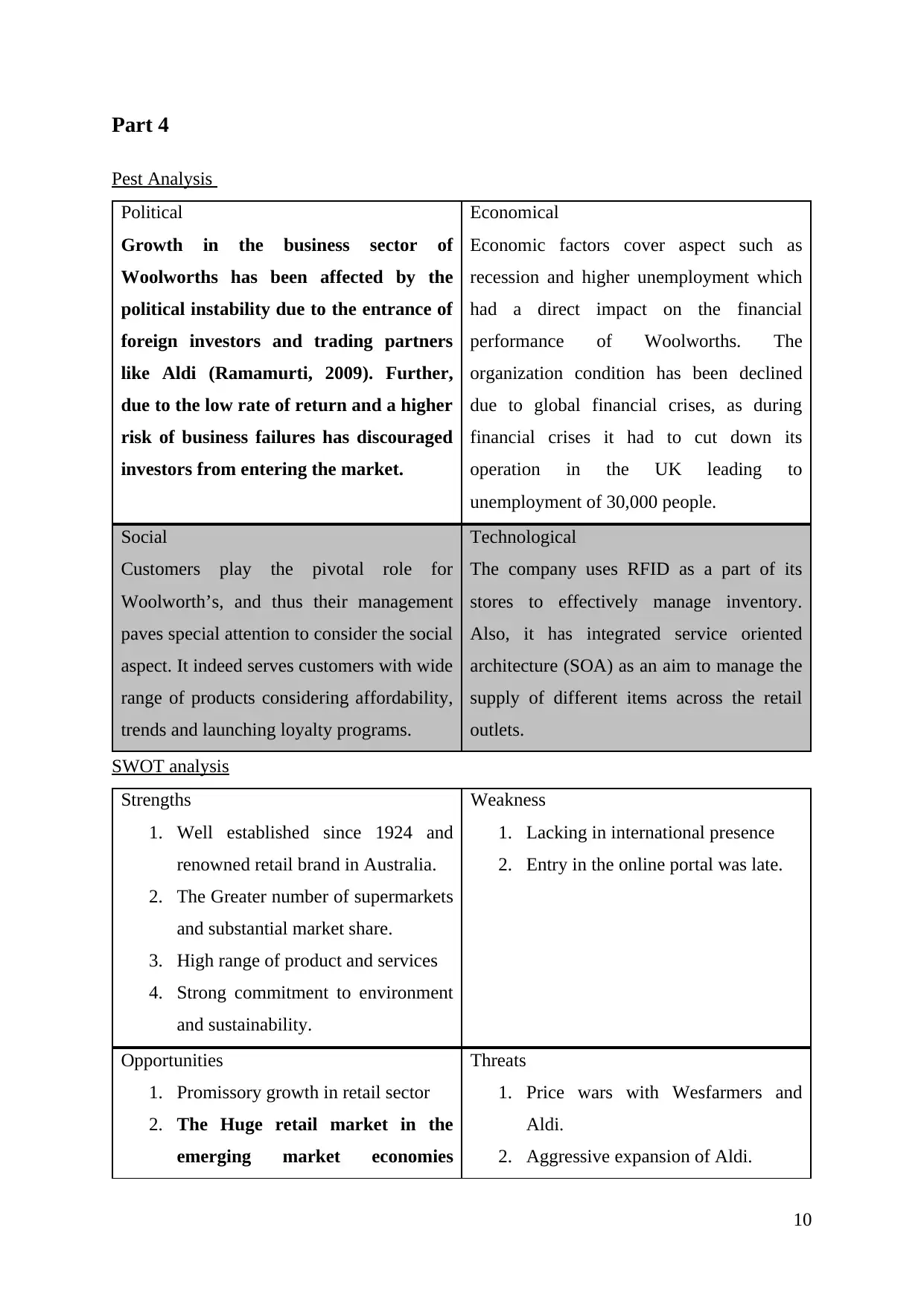
Part 4
Pest Analysis
Political
Growth in the business sector of
Woolworths has been affected by the
political instability due to the entrance of
foreign investors and trading partners
like Aldi (Ramamurti, 2009). Further,
due to the low rate of return and a higher
risk of business failures has discouraged
investors from entering the market.
Economical
Economic factors cover aspect such as
recession and higher unemployment which
had a direct impact on the financial
performance of Woolworths. The
organization condition has been declined
due to global financial crises, as during
financial crises it had to cut down its
operation in the UK leading to
unemployment of 30,000 people.
Social
Customers play the pivotal role for
Woolworth’s, and thus their management
paves special attention to consider the social
aspect. It indeed serves customers with wide
range of products considering affordability,
trends and launching loyalty programs.
Technological
The company uses RFID as a part of its
stores to effectively manage inventory.
Also, it has integrated service oriented
architecture (SOA) as an aim to manage the
supply of different items across the retail
outlets.
SWOT analysis
Strengths
1. Well established since 1924 and
renowned retail brand in Australia.
2. The Greater number of supermarkets
and substantial market share.
3. High range of product and services
4. Strong commitment to environment
and sustainability.
Weakness
1. Lacking in international presence
2. Entry in the online portal was late.
Opportunities
1. Promissory growth in retail sector
2. The Huge retail market in the
emerging market economies
Threats
1. Price wars with Wesfarmers and
Aldi.
2. Aggressive expansion of Aldi.
10
Pest Analysis
Political
Growth in the business sector of
Woolworths has been affected by the
political instability due to the entrance of
foreign investors and trading partners
like Aldi (Ramamurti, 2009). Further,
due to the low rate of return and a higher
risk of business failures has discouraged
investors from entering the market.
Economical
Economic factors cover aspect such as
recession and higher unemployment which
had a direct impact on the financial
performance of Woolworths. The
organization condition has been declined
due to global financial crises, as during
financial crises it had to cut down its
operation in the UK leading to
unemployment of 30,000 people.
Social
Customers play the pivotal role for
Woolworth’s, and thus their management
paves special attention to consider the social
aspect. It indeed serves customers with wide
range of products considering affordability,
trends and launching loyalty programs.
Technological
The company uses RFID as a part of its
stores to effectively manage inventory.
Also, it has integrated service oriented
architecture (SOA) as an aim to manage the
supply of different items across the retail
outlets.
SWOT analysis
Strengths
1. Well established since 1924 and
renowned retail brand in Australia.
2. The Greater number of supermarkets
and substantial market share.
3. High range of product and services
4. Strong commitment to environment
and sustainability.
Weakness
1. Lacking in international presence
2. Entry in the online portal was late.
Opportunities
1. Promissory growth in retail sector
2. The Huge retail market in the
emerging market economies
Threats
1. Price wars with Wesfarmers and
Aldi.
2. Aggressive expansion of Aldi.
10
Paraphrase This Document
Need a fresh take? Get an instant paraphrase of this document with our AI Paraphraser
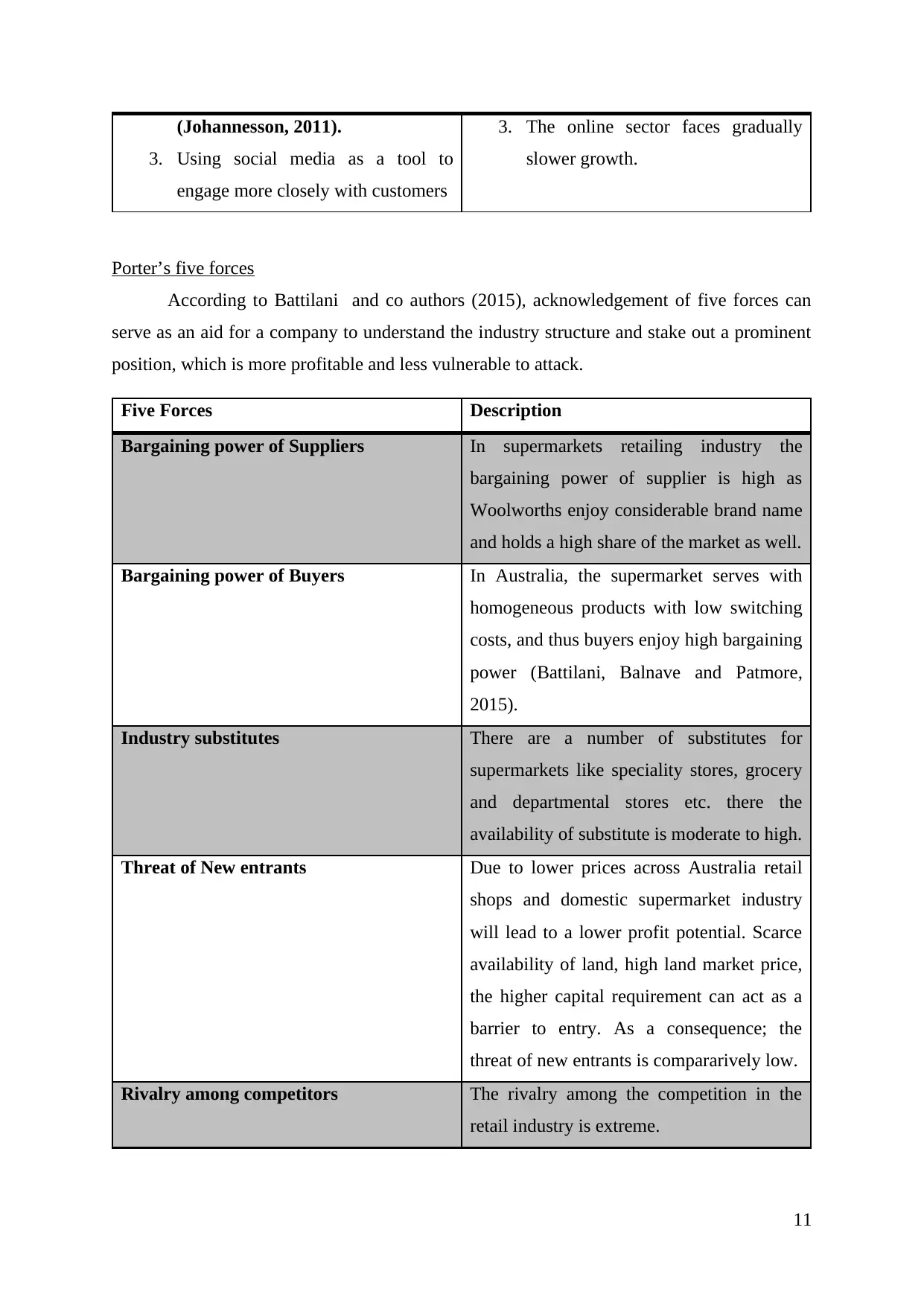
(Johannesson, 2011).
3. Using social media as a tool to
engage more closely with customers
3. The online sector faces gradually
slower growth.
Porter’s five forces
According to Battilani and co authors (2015), acknowledgement of five forces can
serve as an aid for a company to understand the industry structure and stake out a prominent
position, which is more profitable and less vulnerable to attack.
Five Forces Description
Bargaining power of Suppliers In supermarkets retailing industry the
bargaining power of supplier is high as
Woolworths enjoy considerable brand name
and holds a high share of the market as well.
Bargaining power of Buyers In Australia, the supermarket serves with
homogeneous products with low switching
costs, and thus buyers enjoy high bargaining
power (Battilani, Balnave and Patmore,
2015).
Industry substitutes There are a number of substitutes for
supermarkets like speciality stores, grocery
and departmental stores etc. there the
availability of substitute is moderate to high.
Threat of New entrants Due to lower prices across Australia retail
shops and domestic supermarket industry
will lead to a lower profit potential. Scarce
availability of land, high land market price,
the higher capital requirement can act as a
barrier to entry. As a consequence; the
threat of new entrants is compararively low.
Rivalry among competitors The rivalry among the competition in the
retail industry is extreme.
11
3. Using social media as a tool to
engage more closely with customers
3. The online sector faces gradually
slower growth.
Porter’s five forces
According to Battilani and co authors (2015), acknowledgement of five forces can
serve as an aid for a company to understand the industry structure and stake out a prominent
position, which is more profitable and less vulnerable to attack.
Five Forces Description
Bargaining power of Suppliers In supermarkets retailing industry the
bargaining power of supplier is high as
Woolworths enjoy considerable brand name
and holds a high share of the market as well.
Bargaining power of Buyers In Australia, the supermarket serves with
homogeneous products with low switching
costs, and thus buyers enjoy high bargaining
power (Battilani, Balnave and Patmore,
2015).
Industry substitutes There are a number of substitutes for
supermarkets like speciality stores, grocery
and departmental stores etc. there the
availability of substitute is moderate to high.
Threat of New entrants Due to lower prices across Australia retail
shops and domestic supermarket industry
will lead to a lower profit potential. Scarce
availability of land, high land market price,
the higher capital requirement can act as a
barrier to entry. As a consequence; the
threat of new entrants is compararively low.
Rivalry among competitors The rivalry among the competition in the
retail industry is extreme.
11
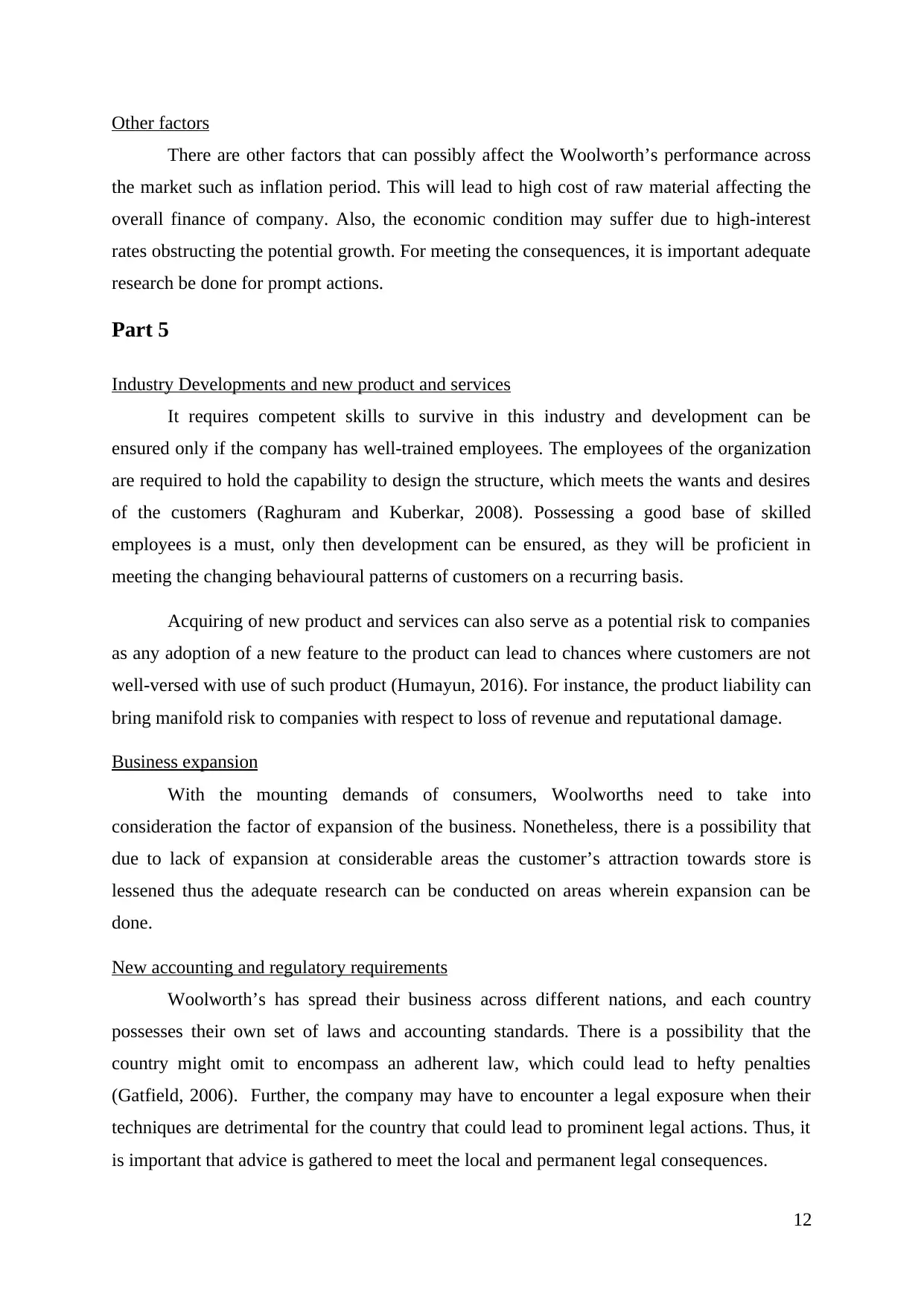
Other factors
There are other factors that can possibly affect the Woolworth’s performance across
the market such as inflation period. This will lead to high cost of raw material affecting the
overall finance of company. Also, the economic condition may suffer due to high-interest
rates obstructing the potential growth. For meeting the consequences, it is important adequate
research be done for prompt actions.
Part 5
Industry Developments and new product and services
It requires competent skills to survive in this industry and development can be
ensured only if the company has well-trained employees. The employees of the organization
are required to hold the capability to design the structure, which meets the wants and desires
of the customers (Raghuram and Kuberkar, 2008). Possessing a good base of skilled
employees is a must, only then development can be ensured, as they will be proficient in
meeting the changing behavioural patterns of customers on a recurring basis.
Acquiring of new product and services can also serve as a potential risk to companies
as any adoption of a new feature to the product can lead to chances where customers are not
well-versed with use of such product (Humayun, 2016). For instance, the product liability can
bring manifold risk to companies with respect to loss of revenue and reputational damage.
Business expansion
With the mounting demands of consumers, Woolworths need to take into
consideration the factor of expansion of the business. Nonetheless, there is a possibility that
due to lack of expansion at considerable areas the customer’s attraction towards store is
lessened thus the adequate research can be conducted on areas wherein expansion can be
done.
New accounting and regulatory requirements
Woolworth’s has spread their business across different nations, and each country
possesses their own set of laws and accounting standards. There is a possibility that the
country might omit to encompass an adherent law, which could lead to hefty penalties
(Gatfield, 2006). Further, the company may have to encounter a legal exposure when their
techniques are detrimental for the country that could lead to prominent legal actions. Thus, it
is important that advice is gathered to meet the local and permanent legal consequences.
12
There are other factors that can possibly affect the Woolworth’s performance across
the market such as inflation period. This will lead to high cost of raw material affecting the
overall finance of company. Also, the economic condition may suffer due to high-interest
rates obstructing the potential growth. For meeting the consequences, it is important adequate
research be done for prompt actions.
Part 5
Industry Developments and new product and services
It requires competent skills to survive in this industry and development can be
ensured only if the company has well-trained employees. The employees of the organization
are required to hold the capability to design the structure, which meets the wants and desires
of the customers (Raghuram and Kuberkar, 2008). Possessing a good base of skilled
employees is a must, only then development can be ensured, as they will be proficient in
meeting the changing behavioural patterns of customers on a recurring basis.
Acquiring of new product and services can also serve as a potential risk to companies
as any adoption of a new feature to the product can lead to chances where customers are not
well-versed with use of such product (Humayun, 2016). For instance, the product liability can
bring manifold risk to companies with respect to loss of revenue and reputational damage.
Business expansion
With the mounting demands of consumers, Woolworths need to take into
consideration the factor of expansion of the business. Nonetheless, there is a possibility that
due to lack of expansion at considerable areas the customer’s attraction towards store is
lessened thus the adequate research can be conducted on areas wherein expansion can be
done.
New accounting and regulatory requirements
Woolworth’s has spread their business across different nations, and each country
possesses their own set of laws and accounting standards. There is a possibility that the
country might omit to encompass an adherent law, which could lead to hefty penalties
(Gatfield, 2006). Further, the company may have to encounter a legal exposure when their
techniques are detrimental for the country that could lead to prominent legal actions. Thus, it
is important that advice is gathered to meet the local and permanent legal consequences.
12
⊘ This is a preview!⊘
Do you want full access?
Subscribe today to unlock all pages.

Trusted by 1+ million students worldwide
1 out of 18
Related Documents
Your All-in-One AI-Powered Toolkit for Academic Success.
+13062052269
info@desklib.com
Available 24*7 on WhatsApp / Email
![[object Object]](/_next/static/media/star-bottom.7253800d.svg)
Unlock your academic potential
Copyright © 2020–2025 A2Z Services. All Rights Reserved. Developed and managed by ZUCOL.





